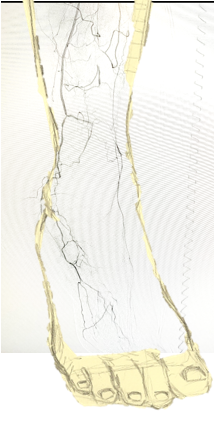Wounds are a symptom of disease, and usually the first disease we have to rule out in patients with lower extremity wounds is poor perfusion. Arterial disease is the most common reason, but not the only one. I rely on skin perfusion pressure (SPP) to determine whether the perfusion specifically to the area of the wound is adequate. I am going to post a series of articles explaining why I must have this machine or I can’t provide adequate care.
–Caroline
Because sometimes the wound isn’t the most important problem…
This 77 y.o. diabetic woman has a small left great toe plantar ulcer which began about 4 months prior to her visit. The ulcer doesn’t look bad at all. Let’s just put an “advanced dressing” on it and call it a day!
On her first visit, I performed arterial screening with skin perfusion pressure and the SPP on the dorsal left foot is only 22 mmHg with a low amplitude pulse volume recording (PVR) suggesting she has significant arterial disease on the left. I also took a history and she complains of pain in her left leg that requires her to sleep in a chair and of cramping in the left leg when she walks that resolves when she rests. Her problem isn’t her toe, it’s her arterial supply. This is a woman about to lose her leg. Based on the fact she has rest pain and claudication, Dr. David Kuten took her to the cath lab. You can see that she has almost no flow to her foot in this angiogram. (I superimposed a sketch of the foot and lower leg over her angiogram. The squiggly lines are arteries, and note that there aren’t any on her foot . . .)

Dr. Kuten performed a successful endovascular revascularization. This probably saved her leg.
What do we learn from this?
- I admit it, SPP should not have been required to know this woman had arterial disease when she had rest pain and claudication.
- However, when I find an SPP like this, most endovascular doctors feel comfortable taking a patient straight to the cath lab. We don’t wait around for an arterial Doppler.
- Her toe didn’t look bad and I would venture to guess that a lot of wound care doctors would not have sent this woman for arterial studies. But, we do them in the wound center, on every patient with a lower extremity wound, every time.
Stay tuned,
–Caroline

Dr. Fife is a world renowned wound care physician dedicated to improving patient outcomes through quality driven care. Please visit my blog at CarolineFifeMD.com and my Youtube channel at https://www.youtube.com/c/carolinefifemd/videos
The opinions, comments, and content expressed or implied in my statements are solely my own and do not necessarily reflect the position or views of Intellicure or any of the boards on which I serve.




What should I do